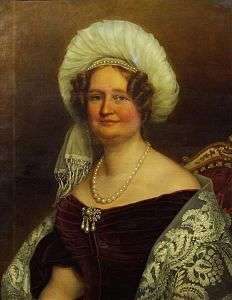Princess Maria Augusta of Saxony
Maria Augusta Nepomucena Antonia Francisca Xaveria Aloysia (German: Maria Augusta Nepomucena Antonia Franziska Xaveria Aloysia; Polish: Maria Augusta Nepomucena Antonia Franciszka Ksaweria Alojzia) of Saxony (born Dresden, 21 June 1782; died Dresden, 14 March 1863) of the House of Wettin was the daughter of Frederick Augustus I of Saxony and Amalie of Zweibrücken-Birkenfeld.
| Princess Maria Augusta | |
|---|---|
 | |
| Born | 21 June 1782 Dresden |
| Died | 14 March 1863 (aged 80) Dresden |
| Burial | |
| House | Wettin |
| Father | Frederick Augustus I of Saxony |
| Mother | Amalie of Zweibrücken-Birkenfeld |
| Religion | Roman Catholicism |
Her father, Frederick Augustus, was the King of Saxony and prince of the Duchy of Warsaw. She was his only child to reach adulthood. Her family had a claim to the throne of Poland (Polish–Lithuanian Commonwealth) and the Constitution of 3 May 1791 named her as a potential successor to the Polish throne if the male line of the Wettin family were to end.[1] In Poland, she was called the "infanta of Poland" and a marriage for her considered with Stanisław Poniatowski, a nephew of the Polish king.[2] Her father's hesitation in accepting this proposal and the subsequent Partitions of Poland prevented this from occurring. After the formation of the Duchy of Warsaw, she was widely regarded as her father's successor there, despite the fact that the Duchy was bound by Salic law.[3]
Plans to marry her to a family that would be able to strengthen its claim on Poland failed, as none of the contemporary powers wanted to strengthen Saxony or restore the Polish kingdom. One of her potential suitors was Józef Poniatowski, the cousin of her earlier suggested spouse Stanisław.
References
-

- Zamoyski, Adam. The last king of Poland.
-
